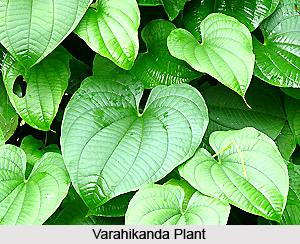 Varahikanda, is an Indian Medicinal Plant, which bears the botanical name Dioscoreaceae Dioscorea bulbifera. Varahikanda is commonly found in the Himalayas, at an altitude of 1850 metres. Varahikanda is known by several names across Indian sub-continent. In Bengali, Varahikanda is known as Banalu, Chamalu.Gaichaalu, kuku-ralu and suralu. In English, this medicinal plant is known as bulb-bearing yam. In Gujarati, Varahikanda is known as salvinavelya, suariya, varahikanda; in Hindi it is agitha, karukanda, pitaalu, Ratalu Suaralu while in Kannada it is known as heggenasu. Varahikanda is also called karando in Konkani and kattukachil in Malayalam. In Maharashtra Varahikanda is known as dukarakanda, gathalu, karukarinda, mataru. In Oriya it is called pita alu. The Punjabi name of Varahikanda is zaminkhand. In Tamil, this plant is called kat-tukkilangu. kodikilangu, pannukilangu and chedupaddudumpa, malakakaya-pendalamu in Telugu. Varahikanda is known as zaminekand in Urdu.
Varahikanda, is an Indian Medicinal Plant, which bears the botanical name Dioscoreaceae Dioscorea bulbifera. Varahikanda is commonly found in the Himalayas, at an altitude of 1850 metres. Varahikanda is known by several names across Indian sub-continent. In Bengali, Varahikanda is known as Banalu, Chamalu.Gaichaalu, kuku-ralu and suralu. In English, this medicinal plant is known as bulb-bearing yam. In Gujarati, Varahikanda is known as salvinavelya, suariya, varahikanda; in Hindi it is agitha, karukanda, pitaalu, Ratalu Suaralu while in Kannada it is known as heggenasu. Varahikanda is also called karando in Konkani and kattukachil in Malayalam. In Maharashtra Varahikanda is known as dukarakanda, gathalu, karukarinda, mataru. In Oriya it is called pita alu. The Punjabi name of Varahikanda is zaminkhand. In Tamil, this plant is called kat-tukkilangu. kodikilangu, pannukilangu and chedupaddudumpa, malakakaya-pendalamu in Telugu. Varahikanda is known as zaminekand in Urdu.
Varahikanda is an annual climber having smooth stems that spins clockwise to the left. The solitary tube of Varahikanda varies in shapes and sizes which ranges from globose to pyriform and can be small and rounded. Varahikanda have purplish-black or earth-coloured skin that is covered with small feeding roots and its sticky flesh is white to lemon yellow coloured. The leaves of Varahikanda are alternatively arranged and are oval-shaped. The apex of the leaves narrows to the slender point. The lobes are rounded which are joined by parallel cross-nerve at the base. There are numerous bulb-shaped growths arising from the leaf axil, known as the Bulbils. These Bulbils are brown colored that vary in shape. The flowers Varahikanda plants are greenish or purplish colored bearing axillary clusters. The fruits of these medicinal plants are oblong shaped and are fleshy. The seeds of Varahikanda, an Indian medicinal plant, are winged at the base. In Central India flowering of Varahikanda occurs between July and September and the fruiting takes place from October to December.
According to the Ayurveda, the tuber of Varahikanda is considered bitter, pungent, tonic, alterative, aphrodisiac, stomachic and anthelmintic. These tubers are reckoned for treatment of diseases like dyspepsia, urinary discharges, leucoderma, bronchitis, biliousness, tumours and strangury. In Unani medicinal traditions too this Indian medicinal plant is of great use. The tubers of Varahikanda are considered as expectorant and astringent to the bowels. The Varahikanda tubers also treat asthma, bronchitis and abdominal pains. The dried and powdered tubers of Varahikanda also possess medicinal applications as they can be used to heal ulcers, piles and dysentery. The bulbils of Varahikanda are used externally to promote healing of sores.



















